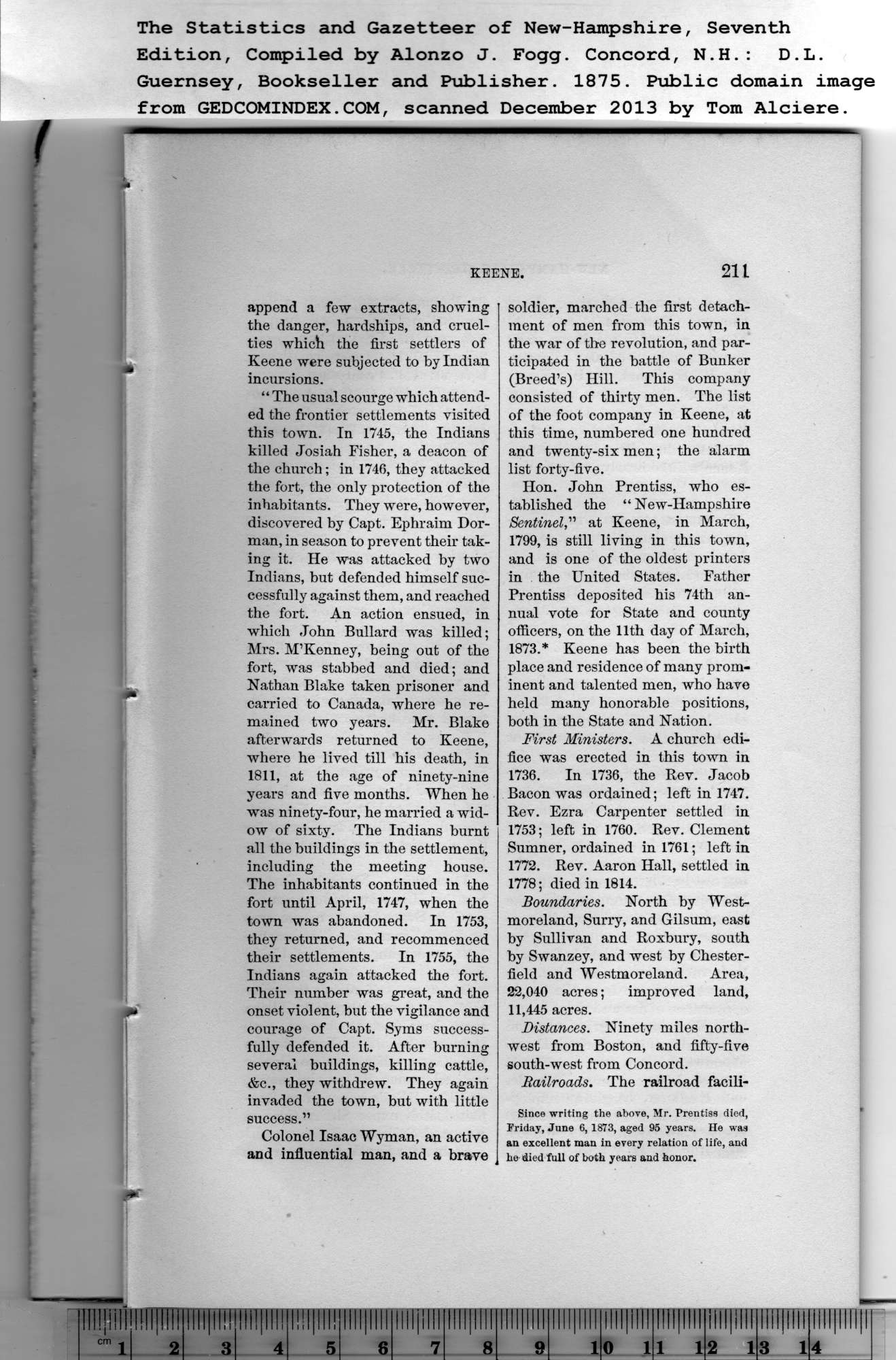|
append a few extracts, showing
the danger, hardships, and cruel-
ties which the first settlers of
Keene were subjected to by Indian
incursions.
“ The usual scourge which attend-
ed the frontier settlements visited
this town. In 1745, the Indians
killed Josiah Fisher, a deacon of
the church; in 1746, they attacked
the fort, the only protection of the
inhabitants. They were, however,
discovered by Capt. Ephraim Dor-
man, in season to prevent their tak-
ing it. He was attacked by two
Indians, but defended himself suc-
cessfully against them, and reached
the fort. An action ensued, in
which John Bullard was killed;
Mrs. M’Kenney, being out of the
fort, was stabbed and died; and
Nathan Blake taken prisoner and
carried to Canada, where he re-
mained two years. Mr. Blake
afterwards returned to Keene,
where he lived till his death, in
1811, at the age of ninety-nine
years and five months. When he
was ninety-four, he married a wid-
ow of sixty. The Indians burnt
all the buildings in the settlement,
including the meeting house.
The inhabitants continued in the
fort until April, 1747, when the
town was abandoned. In 1753,
they returned, and recommenced
their settlements. In 1755, the
Indians again attacked the fort.
Their number was great, and the
onset violent, but the vigilance and
courage of Capt. Syms success-
fully defended it. After burning
several buildings, killing cattle,
&c., they withdrew. They again
invaded the town, but with little
success.” |
Colonel Isaac Wyman, an active
and influential man, and a brave
soldier, marched the first detach-
ment of men from this town, in.
the war of the revolution, and par-
ticipated in the battle of Bunker
(Breed’s) Hill. This company
consisted of thirty men. The list
of the foot company in Keene, at
this time, numbered one hundred
and twenty-six men; the alarm
list forty-five.
Hon. John Prentiss, who es-
tablished the “New-Hampshire
Sentinel,” at Keene, in March,
1799, is still living in this town,
and is one of the oldest printers
in the United States. Father
Prentiss deposited his 74th an-
nual vote for State and county
officers, on the 11th day of March,
1873.* Keene has been the birth
place and residence of many prom-
inent and talented men, who have
held many honorable positions,
both in the State and Nation.
First Ministers. A church edi-
fice was erected in this town in
1736. In 1736, the Rev. Jacob
Bacon was ordained; left in 1747.
Rev. Ezra Carpenter settled in
1753; left in 1760. Rev. Clement
Sumner, ordained in 1761; left in
1772. Rev. Aaron Hall, settled in
1778; died in 1814.
Boundaries. North by West-
moreland, Surry, and Gilsum, east
by Sullivan and Roxbury, south
by Swanzey, and west by Chester-
field and Westmoreland. Area,
22,040 acres; improved land,
11,445 acres.
Distances. Ninety miles north-
west from Boston, and fifty-five
south-west from Concord.
Railroads. The railroad facili-
Since writing the above, Mr. Prentiss died,
Friday, June 6, 1873, aged 95 years. He was
an excellent man in every relation of life, and
he died full of both years and honor. |
